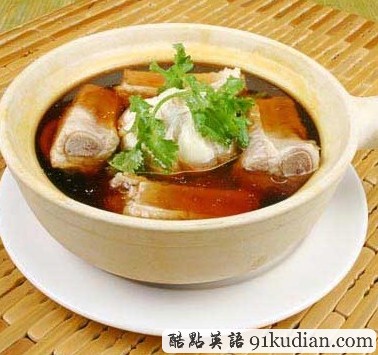环球之旅:一同享用东南亚美味肉骨茶
肉骨茶是东南亚的美食之一。当初下南洋创业的华人面对繁重的劳动,以中药炖猪骨来维持健康,一不小心造就了如今肉骨茶的美誉。各地肉骨茶的做法虽不尽相同,却都极尽美味。很多当地人已然习惯了每天早上吃一碗肉骨茶,来此旅游的人也都慕名而来。
 Most overseas Chinese, especially those living in South East Asia, have tried bak kut teh.
Most overseas Chinese, especially those living in South East Asia, have tried bak kut teh.
大多数海外华人,尤其是居住在东南亚地区的海外华人都品尝过肉骨茶。
Pork rib tea is also called bak kut teh locally, which literally means “meat bone tea”, pronounced in the dialect of Fujian province in China. Pork rib contains both meat and bones, thus offering both nutrition and calcium for human body, especially after it is simmered for a long time with Chinese herbs and spices. It is usually served with rice or with noodles.
Pork rib tea 在当地也叫bak kut teh,字面意思就是“肉骨茶”,发音源自中国福建省的方言。猪肋排既有肉也有骨头,尤其是经过与中药材和调味品长时间的慢火煲炖后,可为人体提供营养和钙质。肉骨茶通常用来搭配米饭或面条。
There are different versions of bak kut teh. In Singapore, there are three types of bak kut teh. The most common variant is the Teochew style, which is light in color but uses more pepper in the soup. The Hoklo (Hokkien), who prefer saltier food, use more soy sauce, which results in a darker soup. The Cantonese, with soup-drinking culture, add medicinal herbs to create a stronger flavoured soup.
肉骨茶有很多不同的做法。在新加坡有三种肉骨茶:最常见的是潮州肉骨茶,色泽清淡,但汤中胡椒味儿较浓;福建肉骨茶偏爱重口味,放的酱油较多,因此色泽偏深;广东肉骨茶因为当地特有的煲汤文化,加入了一些中药材,因此带有浓厚的药材味道。
Bak Kut Teh has its origin in port Klang area of the present day Malaysia, during British colonial administration. In those early pioneering days, much of port activities relied on Chinese migrant coolies to do the heavy manual work. They needed something nourishing to maintain their good health while toiling in the hot and humid climate. Someone with knowledge of Traditional Chinese Medicine (TCM) came out with a secret recipe of using herbs and spices to cook with pork. After cooking, the soup always takes on the color of tea.
肉骨茶最早出现在英国殖民统治下的巴生港,位于今天的马来西亚。在最初开拓的岁月里,很多港口作业都是靠那些从中国移居到当地的苦力用繁重的体力劳动来完成的。在炎热潮湿的气候下,他们需要吃一些有营养的食物以维持身体健康。一些具有传统中医知识的人提出了一个秘方,就是用中草药和调味料一起炖猪骨。炖好之后,骨汤往往呈现出茶色。
The other explanation is that tea is always served after eating it. Among Chinese people, there is this concept of drinking warm tea after a meal, particularly if the meal is oily. The purpose of doing this is to flush out the oil in the digestive tract.
另一种说法是在吃完猪骨汤之后通常要饮茶。中国人有餐后喝热茶的传统,尤其是当膳食比较油腻的时候。这样做的目的是清洗掉消化道中的油脂。
The ingredients of the pork rib tea are pork spare ribs, white peppercorns, garlic, mushrooms, coriander leaves, dried liquorice root, red chili, dark soya and light soya.
猪骨茶的制造材料是猪肋排、白胡椒、大蒜、蘑菇、芫荽叶、干甘草根、红辣椒、老抽和生抽。
《环球之旅:一同享用东南亚美味肉骨茶》永久阅读地址: http://91kudian.com/yingyu/4004/
已有0条评论,点击查看发表评论